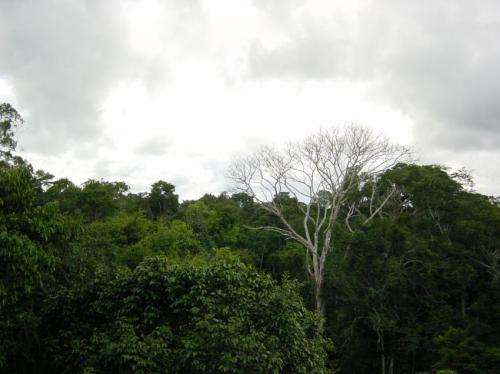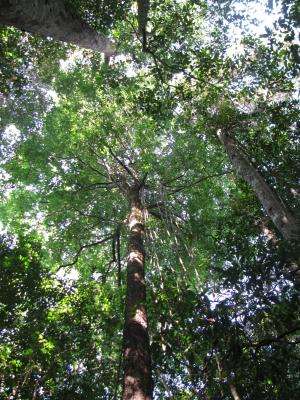February 6, 2014 report
Study shows extra Amazon greenness during drought an optical illusion

(Phys.org) —A diverse group of researchers led by a team out of NASA's Goddard Space Flight Center has dispelled the notion that the Amazon basin becomes greener during times of less rain. In their paper published in the journal Nature, the team describes how they undertook two separate studies of Amazon foliage and how both showed that the apparent increase in greenness in satellite images was due to an optical illusion. Kamel Soudana and Chrstophe Francois offer some perspective on the team's findings in an accompanying News & Views piece in the same journal.
Back in 2003 satellite sensor data indicated that the foliage below in the Amazon basin was reflecting back more near-infrared light during a drought year than was recorded in non-drought years. This suggested that more photosynthesis was going on which would mean the Amazon rain forest was greener during the drought than during other times. Other sensor data appeared to back up that result, as the forest appeared to become greener during the dry season each year. Researchers reporting on this apparent oddity suggested in a published paper that the increase in greenness proved that sunlight was the primary driver behind photosynthesis, not water amounts. Since that time other researchers have argued that some other factor must be at play (such as differences in cloud cover) because it simply wasn't logical to conclude that a rain forest would grow greener during dry times. In this new effort, the researchers have taken a more serious approach to proving that the original satellite data was being interpreted incorrectly.
To settle the matter once and for all, the researchers attacked the problem in two ways. The first involved using a ray-tracing technique that allowed for simulating the trajectories of photons striking leaves. Doing so showed that what appeared to be a greening of the Amazon forest was actually an illusion due to shadowing that occurred when the remote sensor was behind the sun.

In the second experiment, the team used data from lidar satellite observations—they're not impacted by sensor geometry because a laser is used instead of sunlight as the source of illumination. The second study agreed with the first—the apparent greening of the Amazon rain forest was a simple optical illusion caused by sun-leaf shadowing effects.
This new study appears to settle the matter once and for all, but of course doesn't settle the argument regarding the primary driver of photosynthesis—something that is becoming increasingly important as global warming causes changes to weather systems in tropical zones.
More information: Amazon forests maintain consistent canopy structure and greenness during the dry season, Nature (2014) DOI: 10.1038/nature13006
Abstract
The seasonality of sunlight and rainfall regulates net primary production in tropical forests. Previous studies have suggested that light is more limiting than water for tropical forest productivity, consistent with greening of Amazon forests during the dry season in satellite data. We evaluated four potential mechanisms for the seasonal green-up phenomenon, including increases in leaf area or leaf reflectance, using a sophisticated radiative transfer model8 and independent satellite observations from lidar and optical sensors. Here we show that the apparent green up of Amazon forests in optical remote sensing data resulted from seasonal changes in near-infrared reflectance, an artefact of variations in sun-sensor geometry. Correcting this bidirectional reflectance effect eliminated seasonal changes in surface reflectance, consistent with independent lidar observations and model simulations with unchanging canopy properties. The stability of Amazon forest structure and reflectance over seasonal timescales challenges the paradigm of light-limited net primary production in Amazon forests and enhanced forest growth during drought conditions. Correcting optical remote sensing data for artefacts of sun-sensor geometry is essential to isolate the response of global vegetation to seasonal and interannual climate variability.
Journal information: Nature
© 2014 Phys.org



















